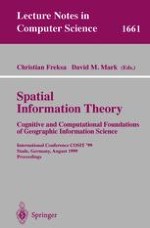1999 | OriginalPaper | Buchkapitel
The Nature of Landmarks for Real and Electronic Spaces
verfasst von : Molly E. Sorrows, Stephen C. Hirtle
Erschienen in: Spatial Information Theory. Cognitive and Computational Foundations of Geographic Information Science
Verlag: Springer Berlin Heidelberg
Enthalten in: Professional Book Archive
Aktivieren Sie unsere intelligente Suche, um passende Fachinhalte oder Patente zu finden.
Wählen Sie Textabschnitte aus um mit Künstlicher Intelligenz passenden Patente zu finden. powered by
Markieren Sie Textabschnitte, um KI-gestützt weitere passende Inhalte zu finden. powered by
Landmarks are significant in one’s formation of a cognitive map of both physical environments and electronic information spaces. Landmarks are defined in physical space as having key characteristics that make them recognizable and memorable in the environment. The challenge of defining measurable features of landmarks that can be used in designing and recognizing landmarks in information spaces is explored. By drawing on diverse areas such as urban planning, architecture, cognitive science and hypertext, a coherent definition of a landmark is proposed, which is relevant to both physical and electronic spaces. It is argued that landmarks can be classified in terms of visual, cognitive and structural dimensions, which has implications for how environments can be designed or built in such a way that landmarks will emerge appropriately for unique situations.
